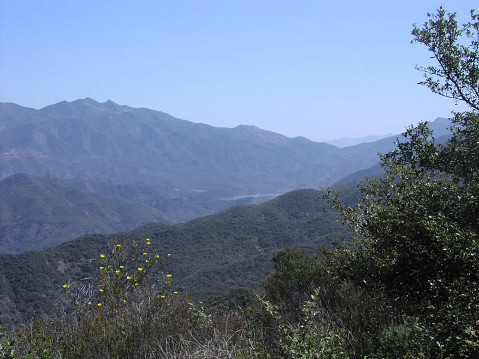Support the Central Coast Heritage Protection Act
Los Padres Forms a Vital Watershed, Biodiverse Habitat, Recreational Destination

As a lifetime explorer, resident, recreationist, and advocate for Los Padres National Forest, I would like to voice my support for Representative Lois Capps’s pending Central Coast Heritage Protection Act.
The most pressing issues of our time can be easily overlaid with the issues related to this legislation. Los Padres is California’s second-largest forest — a world-recognized biodiversity hot spot with habitats containing 468 species of wildlife and over 1,200 plant species, including over 90 species at risk of extinction, more than any other national forest in the state.
Los Padres is also the primary source of drinking water for millions of residents surrounding the forest — including water for the multibillion-dollar farming and nursery industries that surround the forest from Fillmore to Monterey.
As an avid backpacker, mountain biker, hiker, and trail-enthusiast for over 50 years, I understand how valuable recreation is to the people who live and work around this forest. However, the ultimate challenge of our times is to protect for future generations what relatively pristine watershed and undisturbed habitat we have left. Wilderness designation is the best and most proven means we have to protect our public lands — and it still allows for nonmotorized recreation within its boundaries. My years as cofounder and director at Concerned Resource and Environmental Workers (CREW) in Ojai and Sunbow Ecology Center in Ojai showed me firsthand the healing benefits of trekking in wilderness with kids who are in desperate need of this connection to nature: Wilderness is therapy for humans, as much as it is protection from our often heavy hand of development. In the future, generations will not ask, “Why didn’t they develop this more?” They will ask, “Why didn’t they take care of what was left?”
Most people don’t realize how much development is permitted outside of Wilderness-designated areas on our public lands — even “Back Country Nonmotorized” status allows for road construction, resource extraction, communication site development, and energy development. Wilderness is the only proven tool we have to make sure these last remaining stretches of habitat remain sanctuaries for both humans and wildlife.
Additionally, the Central Coast Heritage Protection Act does not close a single mile of existing off-highway vehicle (OHV) routes, nor does it block recreation on any legally existing mountain bike trail route in Los Padres National Forest. The draft legislation also includes close to 160 miles of “wild and scenic river” protection, which helps assure our watersheds remain protected for drinking water and habitat preservation.
It appears to me that much of the opposition voiced has come from some subset of the mountain bikers in the region. In addition to noting “no net loss” of trails currently accessible to mountain bikers, I say this: The most important resources of National Forest are, in descending order, watershed, biological diversity, habitat, other ecosystem services, and then recreation. If a wilderness designation is the best current means to protect the more important resources, then the loss of any one, or even many, form of recreation is a worthwhile concession. There is a much wisdom embedded in the Wilderness Act, and the exclusion of all forms of machinery is certainly part of that wisdom.
To add personal note, as an avid mountain biker for over 25 years, one of my favorite rides was through the Sespe behind my home in Ojai. However, recognizing the importance of wilderness, I happily and openly advocated for the Sespe Wilderness Designation and am grateful for such designation. Of course, I still have full access to the Sespe, by foot or horseback. Considering our current state of ecological overshoot, I am most afraid that when it comes to wilderness, it is not a matter of too much wilderness. I am most afraid it is too little, too late.
As part of the balance between protection and access, the Central Coast Heritage Protection Act includes language to designate the “Condor Trail” National Recreation Trail — a project that I co-conceived and have been actively involved with for almost 15 years.
The Condor Trail is a multi-use, recreational thru-hiking route designed to span the entire Los Padres and ultimately connect the northern and southern portions of Los Padres National Forest by a single hiking trail. The hiking/backpacking/equestrian trail is approximately 420 miles long and extends from Lake Piru and the I-5 (border of Los Angeles and Ventura counties) in the south to Bottchers Gap (just south of Monterey) in the north.
Representative Lois Capps’s introduction of this bill underscores her excellent legacy of environmental protection and hard work in her district. I support this effort whole heartedly, and recognize and applaud the outstanding balance she has struck between habitat protection and continuing access to multi-use recreation. This balance is the result of careful vetting of the proposed designations, extensive consultation with a wide range of stakeholders, and considerable compromise.
When the Central Coast Heritage Protection Act is made into law, future generations will be drawn to Los Padres and the Condor Trail to hike across the more than 400 miles of one of the most biodiverse regions in California — hopefully looking up to see a California condor soaring overhead — yet another example of what foresight and habitat protection can help save for future generations.
Those that will follow us in the future will be able to thank Lois Capps and the supporters of the Central Coast Heritage Protection Act for having the foresight to protect what is most valuable on our public lands.



